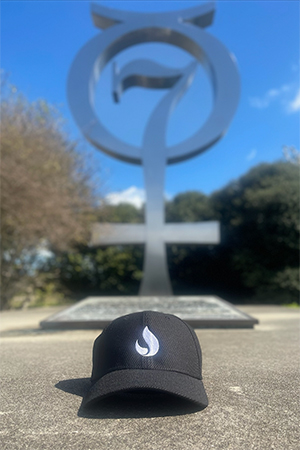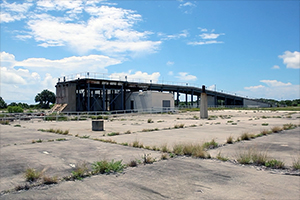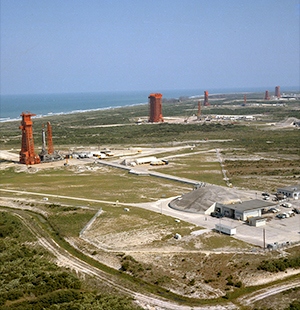March 10, 2023 — The long-retired launch pad where astronaut John Glenn lifted off to become to the first American to orbit Earth is getting a new lease on life.
The U.S. Space Force on Tuesday (March 7) announced it had allocated Space Launch Complex 14 (LC-14) to Stoke Space, a Washington-based company developing a reusable rocket intended to fly daily. In addition to LC-14 being the site where Glenn left the ground in February 1962, the Cape Canaveral, Florida complex also supported the launches of Scott Carpenter, Walter "Wally" Schirra and Gordon Cooper on the three NASA Mercury-Atlas missions that followed.
"We're standing on the shoulders of giants," Andy Lapsa, co-founder and chief executive of Stoke Space, said in a statement. "And we're beyond humbled by the historic significance of LC-14. The opportunity to reactivate this site is a profound responsibility that our entire team holds in the highest regard."
"As we bring LC-14 back to life and carry its legacy into the future, we will be sure to do so in a way that preserves its existing history and pays homage to those who came before us," said Lapsa, who previously led rocket engine development at Blue Origin.
Declared a National Historic Landmark in 1984, LC-14 was originally built to test Atlas missiles in 1957. In addition to the four astronaut flights, the pad was used for 28 launches, including Mercury-Atlas 4 with Enos the chimpanzee aboard in 1961 and seven Atlas-Agena target vehicles for NASA's Gemini program between 1965 and 1966. LC-14 was deactivated in 1967 and was declared "abandoned in place" five years later.
The 155-foot-tall (47-meter) service tower that stood at LC-14 since its start was demolished in late 1976. The 92-foot-long (28-meter) ramp and 22-foot-high (7-meter) launch stand still exist, though both have been degraded by the elements despite a partial restoration effort in 1997.
The pad's original blockhouse was converted into a conference facility in 1998, with Carpenter and Cooper present for its dedication.
Other than the pad's structures (including the reserved parking spaces for the Mercury astronauts), a number of monuments now stand at LC-14 attesting to its historic status. At the entrance to the complex is a large titanium sculpture of the Project Mercury symbol (with a time capsule buried beneath it, not to be opened until 2464) and a granite marker engraved with a launch scene was added to the base of the ramp when the site was deactivated.
It is unclear what, if any, restraints Stoke Space will be under as the company modifies LC-14 for its use. A spokesperson said that they could not discuss specifics at this time, but pointed to the public comments made by Julia Black, Stoke's director of range operations.
"Stoke is well aware of Launch Complex 14's historical significance," said Black, "and will support maintaining that history in addition to enabling a robust launch program. We look forward to adding to its well distinguished accomplishments for America's space program."
In addition to assigning LC-14 to Stoke, the Space Force's Space Launch Delta (SLD) 45 also allocated LC-15 to ABL Space and LC-13 to Phantom Space and Vaya Space. LC-15 was used as a Titan missile site from 1959 to 1964. LC-13 supported Atlas flights, including the launch of five Lunar Orbiter missions and Mariner 3 for NASA, before being deactivated in 1978. Nearly 40 years later in 2015, the site was leased to SpaceX as Landing Zone 1 for its Falcon 9 rocket first stage recoveries.
"Offering excess launch property to CLSPs [commercial launch service providers] fosters development of new space launch systems and helps ensure a strong space launch industrial base for the nation," the Space Force stated in a release.
The U.S. Air Force previously partnered with the University of South Florida's Alliance for Integrated Spatial Technologies (AIST) to virtually preserve sites like LC-14 by using a laser scanner to survey, map and create virtual models of the historic pad structures still standing at the Cape Canaveral Space Force Station (then Air Force Station). The work, which was done in 2014, is one way that the area's history is being saved.
"Congratulations to the new launch providers coming to the Cape! We look forward to seeing your contributions toward the next chapter of space launch innovation," said the staff at the Cape Canaveral Space Force Museum (formerly known as the Air Force Space and Missile Museum), in a statement posted to its social media channels. "LC-14 will continue to serve as a tangible connection to the Cape's rich history, current innovations and future possibilities!" |
|

A baseball cap with the Stoke Space logo sits on the ground in front of the Project Mercury sculpture at the entrance to Launch Complex 14 (LC-14) at Cape Canaveral Space Force Station. (Stoke Space)

What remains of the ramp and launch stand at Launch Complex 14 (LC-14) at the Cape Canaveral Space Force Station. (US Air Force)

Aerial view of Launch Complex 14 with Missile Row visible to the right. Gordon Cooper's Mercury-Atlas 9 rocket is seen atop LC-14 prior to the launch in 1963. (NASA) |
